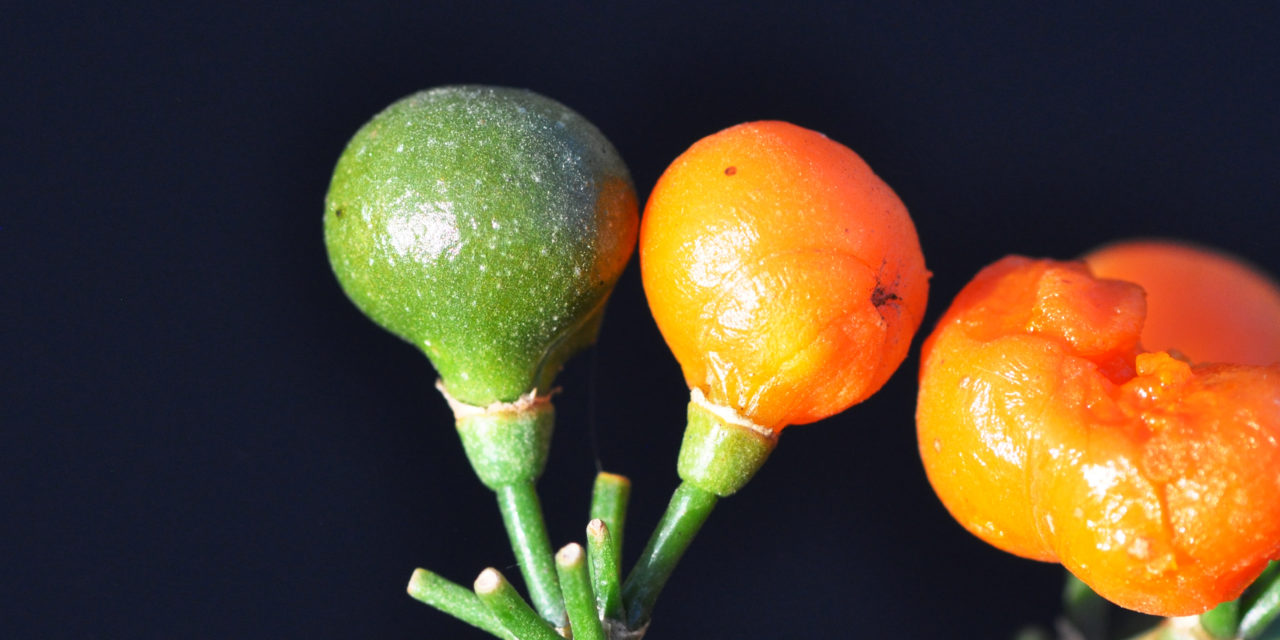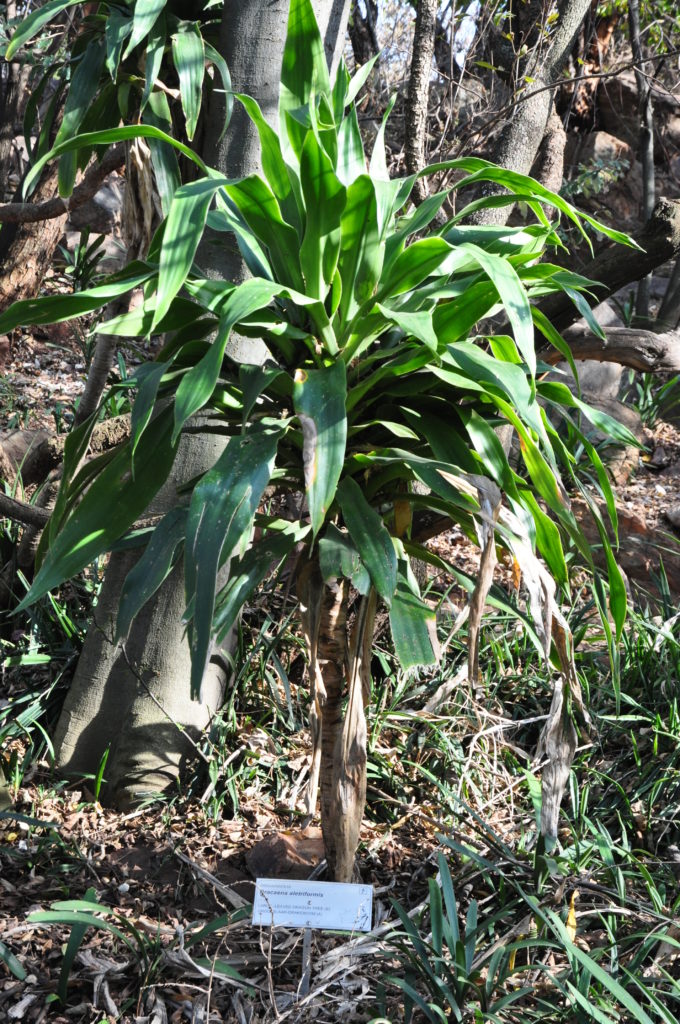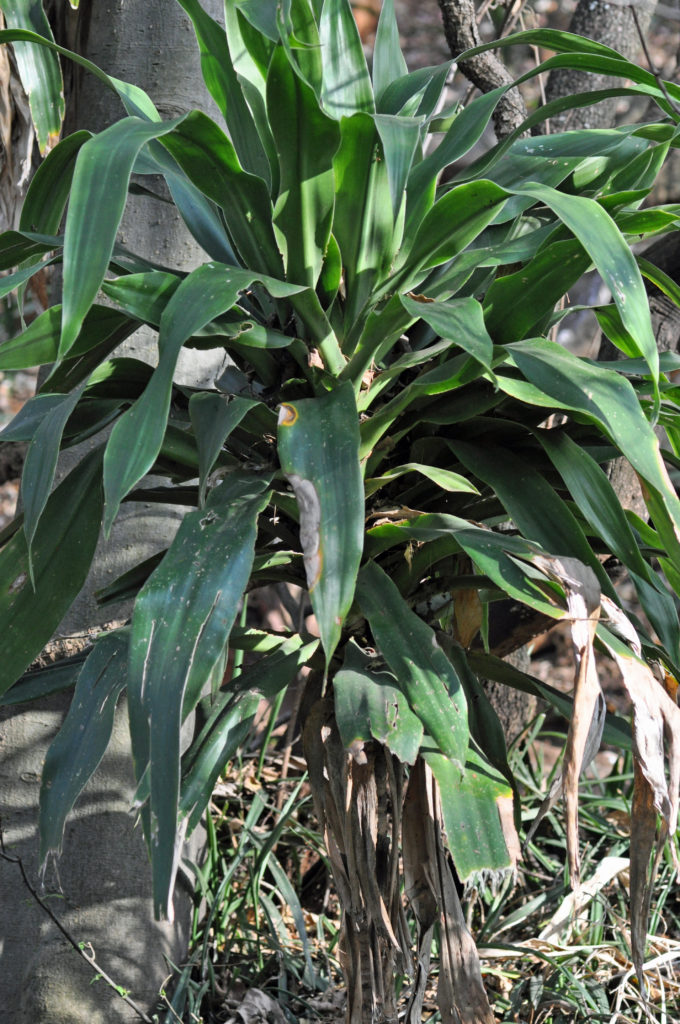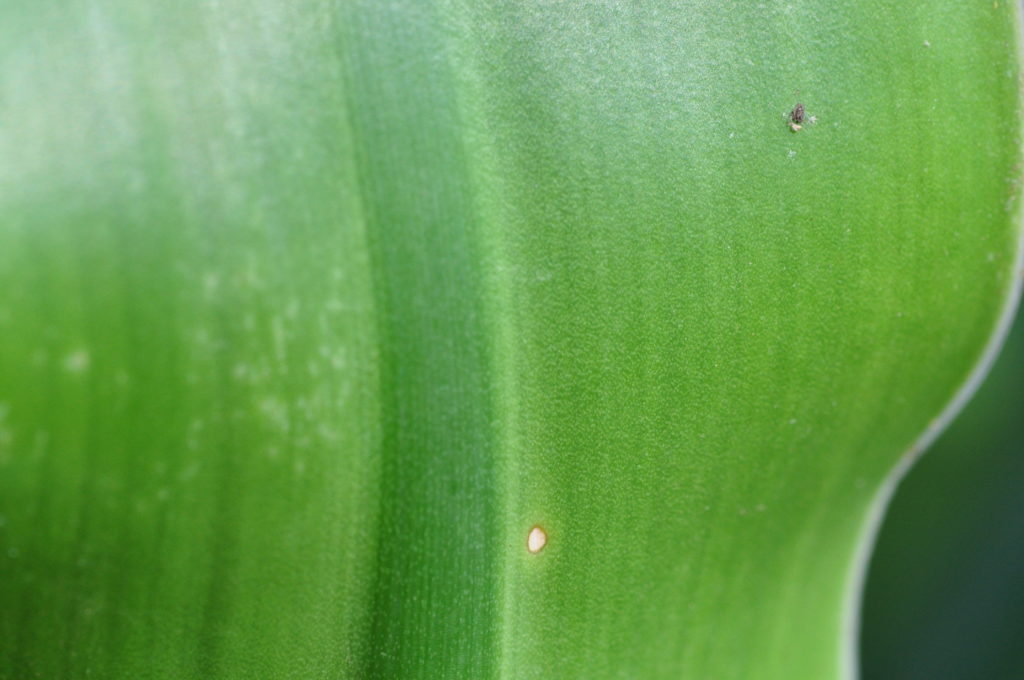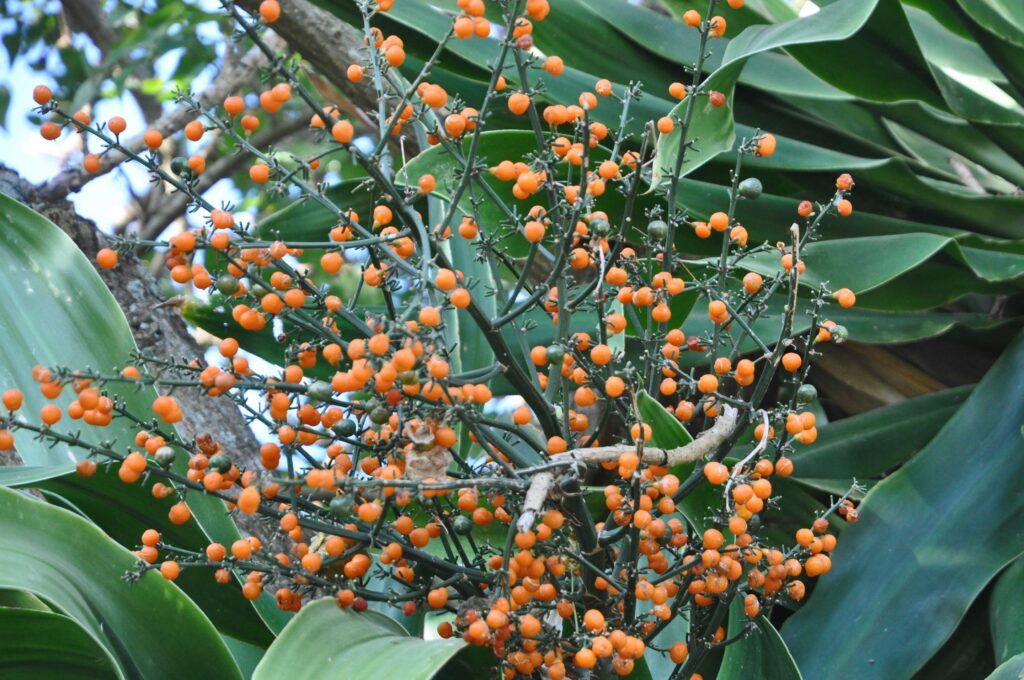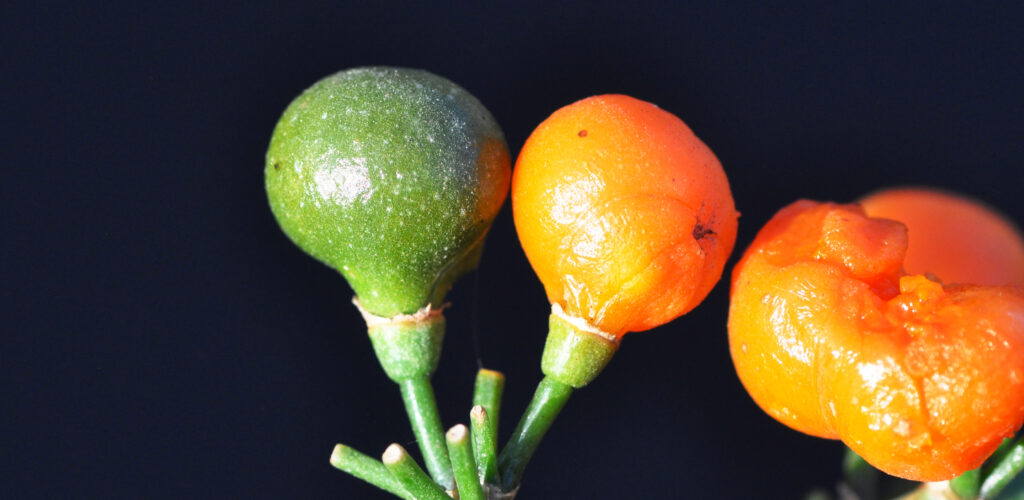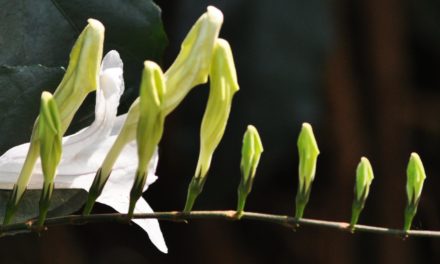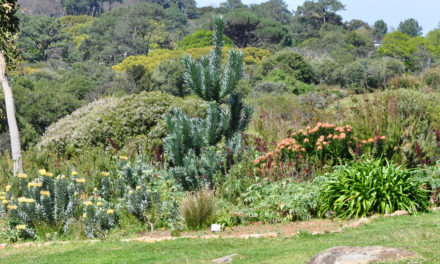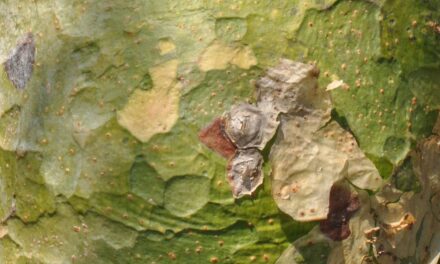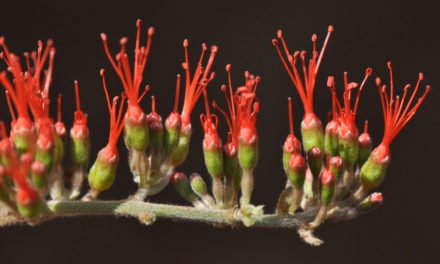General Info – summary
This evergreen possibly branched Tree or woody shrub has smooth bark and may reach 5m high. The strap shaped, parallel-veined and evergreen Leaves occur at branch ends. A petiole is absent, and the base is amplexicaul. Bisexual, 3-merous, nocturnal, regular Flowers are in panicles up to 1m long. 6 tepals surround the 6 stamens & the superior, trilocular ovary. The ripe Fruit is a red-orange berry with 1-3 large bony seeds.
Description
Dracaena aletriformis
Previous Names: Dracaena hookeriana, Dracaena rumphii, Draco hookeriana, Sansevieria paniculate.
SA Tree N0. 30.9.
Common names: (Afr) Grootblaar-drakeboom. (Eng) Large-leaved Dragon tree. (isiXhosa) Ikholokotho, Intelezi, Ishwadi, Umkhoma-khoma. (isiZulu) Igonsi-lasehlathini, Igonsi-lehlathi, Ikholokotho, Itokothoko. (Northern Sotho) Photsoloma. (siSwati) siKhonkhwane. (Tshivenda) Tshila-mbila.
Family Asparagaceae (asparagus family). Previous names include Dracaenaceae and Liliaceae. This family includes about 120 genera and in excess of 2 000 species. Members of Asparagaceae are united primarily by genetic and evolutionary relationships rather than morphological similarities.
Name derivation: Dracaena – a female dragon or named after Sir Francis Drake an English explorer who circumnavigated the world in 1577 and 1580. “Dragon’s blood” is a bright red resin obtainable from some plant species (not this one) including species of Croton, Dracaena, Pterocarpus and others. aletriformis – refers to the similarity to the genus Aletris in the family Nartheciaceae (located in the northern hemisphere) that are perineal herbs with a thick underground rhizome. There are in excess of 100 species in Dracaena. These are mainly found in Africa (4 in South Africa).
Conservation: National Status: L.C. (Least Concern). Assessment Date: 2005 (W. Fodden and L. Potter).
Tree
This occasionally branched Tree (ph0to 348) is up to 5m high and may be a partially woody shrub. The stout Stem (main axis of the plant, the leaf and flower bearing as distinguished from the root-bearing axis), may contain secondary thickening. The smooth, pale, light brown to white Bark (photo 322) covers the soft fibrous stem. The upper part of the stem shows leaf scars (photo 322).
- 348. 2017/08/03 Pretoria NBG. Photo: David Becking.
- 322. 2017/08/03 Pretoria NBG. Photo: David Becking.
Leaves
This evergreen tree has large Leaves concentrated at the end of stems. The glossy green, initially upright young leaves become spreading and half-drooping. The parallel veined leaves (photo 320) are spirally arranged. Individual leaves are narrowly to broadly strap-shaped – up to 1 x 0,11m. Leaves are smooth and entire (with a continuous margin, not in any way indented). The leaves are slightly folded near the middle (photo 318). Each leaf has a Base that is Amplexicaul: (having an enlarged base that encircles the stem). The Petiole (leaf stalk) is absent. The Apex tapers to a narrow-pointed end. Mature leaves may reach 1m long and may be wider than 10cm. Old, shrunken, grey leaves hang down for a short while before shedding: leaving behind a wide leaf scar (photo 322 under Tree). The Midrib is not prominent, but the leaf may bend along this central axis. Prior to drooping, the young leaves emerge upright (photo 318). The entire Margin (with a continuous margin, not in any way indented) is whitish, and the rest of the leaf is dark green (photo 320).
- 318. 2017/08/03 Pretoria NBG. Photo: David Becking.
- 320. 2017/08/03 Pretoria NBG. Photo: David Becking.
Flowers
The white to yellowish-green, shiny, bisexual, sweetly scented Flowers open at night, and are actinomorphic (Regular, symmetrical. Flowers are vertically divisible into similar halves by more than 1 plane passing through the axis). Each fragrant flower is up to 3,5cm long and rests on a Pedicel (the stalk of a single flower – photos 357 & 360 under fruit). They are collectively situated in erect, loose terminal Panicles (indeterminate, green branched inflorescence with stalked flowers). Each greenish, much branched panicle may extend to more than 1m in length (photo 357 – under Fruit). Flowers are bisexual and have a 6-lobed tubular Perianth (the 2 floral envelopes considered together; a collective term for the very similar calyx and corolla parts and are called Tepals). These tepals have recurving lobes are thin and about 2-4cm long. The basal part of the Pedicel becomes a persistent peg. The Receptacle (that expanded tip of the flower stalk from which the floral parts develop) is obconical (resembles an inverted cone) and is persistent in the fruit (photo 360 – under fruit). There are 6 exserted (sticking out) Stamens that are in 2 rows of 3 each and are opposite the perianth lobes. Their inflated Filaments (the usually long slender stalks that supports each anther). Anthers (where the pollen grains are formed are free from each other and arise in the throat of the perianth and end with versatile (hung or attached near the middle, and usually free moving) Anthers that have 2 Thecae (pollen sacks). They face inwards and are longitudinally dehiscent. The superior, trilocular Ovary is sessile. It has a slender Style and a capitate (formed like a head) Stigma. Flowers open at night and attracted insects, including moths, are responsible for Pollination. (Nov-Feb).
Fruit
Each flower panicle develops into an attractive Fruit (photo 357) that is a single, spherical or bi/tri-lobed Berry (a pulpy, indehiscent fruit like a grape or tomato) with a thick pedicel. The berry is up to 2cm in diameter and changes from green to red or orange when mature (photo 360). Each berry contains up to 3 large, rounded or lobed bony black seeds. The remains of the perianth and pedicel are still visible at the base of each club shaped fruit (photo 360). In this photo, the remains of the stigma is also visible on the central fruit. (Feb-Jul & occasionally Aug).
- 357. 2018/06/23 Umngazi. Photo: David Becking.
- 360. 2018/06/23 Umngazi. Photo: David Becking.
Distribution & Ecology
These plants are Located in Eastern Cape, Kwa-Zulu Natal, northern and eastern Gauteng, Mpumalanga, Limpopo, SiSwati (Swaziland), southern Mozambique and northwards to Kenya. They grow in shade – under tree canopies and usually occur near water e.g., in scrub and coastal forests, including Oribi Gorge (inland from Portshepstone in KwaZulu-Natal) and usually below an altitude of close to 1 550m. They also occur in dry scrub and often in association with quartzite (rock composed almost entirely of quartz. It is non-foliated and usually forms from the metamorphosis of sandstone). They also are found in sandstone and frequently form dense stands. Monkeys eat the Fruit. Many birds consume the orange fruit pulp. Birds like the Robin chat as well as mice nest in the Leaves. The insects that visit this tree attract birds. The leaves of Dracaena species are the breeding place for the ornate Bush Night-fighter Butterfly (Artitropa erinnys erinnys). These butterflies are common in forest edges, and forests along the Drakensberg and Wolkberg mountains (Drakensberg tributary through Tzaneen in Limpopo province) and their larvae feed on the leaves of this plant. These butterflies have a wingspan in the region of 6cm.
Ethnobotany
Plants should be Grown from fresh, cleaned seeds or cuttings (they take up to up to 3 weeks to develop). The orange Seed pulp contains a growth inhibitor that must be removed before the seeds are planted. Birds often carry out this function when feeding. Here the seeds pass through the bird – removing the inhibiter. These plants are frost and drought sensitive and should be planted away from direct sunlight in humus rich soil. They tolerate deep shade and grow well in shade and indoors. Local medicine makes use of the Roots. A wide range of the attractive Dracaena plants are now grown around the world. These plants ae widely cultivated in Zimbabwe.
References
Boon, R. 2010. Pooley’s Trees of eastern South Africa. Flora and Fauna Publications Trust, Durban.
Burrows, J.E., Burrows, S.M., Lotter, M.C. & Schmidt, E. 2018. Trees and Shrubs Mozambique. Publishing Print Matters (Pty) Ltd. Noordhoek, Cape Town.
Coates Palgrave, M. 2002. Keith Coates Palgrave Trees of Southern Africa. edn 3. Struik, Cape Town.
Foden, W. & Potter, L. 2005. Dracaena aletriformis (Haw.) Bos. National Assessment: Red List of South African Plants version 2020.1. Accessed on 2023/03/06.
Foden, W. & Potter, L. 2005. Dracaena aletriformis (Haw.) Bos. National Assessment: Red List of South African Plants version 2020.1. Accessed on 2022/01/12.
Schmidt, S. Lotter, M. & McCleland, W. 2002. Trees and Shrubs of Mpumalanga and the Kruger National Park. Jacana.
van Wyk, B. & van Wyk, P. 1997 Field guide to Trees of Southern Africa. Struik, Cape Town.
http://posa.sanbi.org/flora/browse.php?src=SP
https://en.wikipedia.org/wiki/Dracaena_aletriformis \
http://pza.sanbi.org/dracaena-aletriformis
http://succulent-plant.com/families/dracaenaceae.html
https://plants.jstor.org/stable/10.5555/al.ap.flora.flos003942

